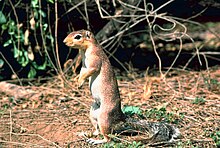Unstriped ground squirrel
| Unstriped ground squirrel | |
|---|---|

| |
| Scientific classification | |
| Domain: | Eukaryota |
| Kingdom: | Animalia |
| Phylum: | Chordata |
| Class: | Mammalia |
| Order: | Rodentia |
| Family: | Sciuridae |
| Tribe: | Xerini |
| Genus: | Xerus Hemprich & Ehrenberg, 1833 |
| Species: | X. rutilus
|
| Binomial name | |
| Xerus rutilus (Cretzschmar, 1828)
| |
The unstriped ground squirrel (Xerus rutilus) is a species of
Description
The unstriped ground squirrel is brownish or tawny in color with a lighter colored front. As the name suggests the X. rutilus differs from other species of
Xerus rutilus is a member of the Xerini tribe, but differs from its sister group
No significant sexual dimorphism is noted in X. rutilus.
Local and indigenous names
In Tigrinya language: ምጹጽላይ or ጨጨራ (mitsutsilay, chechera).[6]
In Turkana: [ekuɲuk], borrowed further in Daasanach: [ɲékuɲug][7]
Ecology
Range and habitat
The unstriped ground squirrel is endemic to Ethiopia,
Diet and foraging
The unstriped ground squirrels demonstrate diurnality[3] with an omnivorous diet consisting of leaves, tree fruits (Adansonia digital), seeds (Commiphora and Acacia trees), other plant materials, and insects.[3] Studies[10] show that X. rutilus is unaffected by poisonous tannins and to some degree eats oxalic-containing foods. X. rutilus has been shown to be uniquely efficient in its capacity to forage for food. This ability is not diminished across a variety of different environments, including those with a poor to moderate food supply.[10]
Behavior
Burrows
X. rutilus are mainly
Dominance hierarchy
Although not territorial, a dominance hierarchy exists with male squirrels being dominant over females and younger squirrels. X. rutilus demonstrate dominance via vocalization, tail displays, and physical lunges.[3][11][12]
Physiology
Thermoregulation
Unstriped ground squirrels generally reside in hot
References
- ^ Grubb, P. & Oguge, N. (2008). "Xerus rutilus". IUCN Red List of Threatened Species. 2008. Retrieved 8 January 2009.
- ^ Coe, M. 1972. The South Turkana expedition. Scientific papers IX. Ecological studies of the small mammals of South Turkana. Geographical Journal, 138: 316–338.
- ^ JSTOR 3504277.
- S2CID 84441705.
- ^ S2CID 86163438.
- ^ ISBN 978-3-030-04954-6. Retrieved 18 June 2019.
- ^ Tosco, Mauro (2001). The Dhaasanac Language. Köln: Rudiger Köppe. p. 576.
- ^ "Xerus rutilus". The IUCN Red List of Threatened Species. IUCN (International Union for Conservation of Nature). 2008.
- S2CID 35874572.
- ^ a b Ecological factors affecting the foraging behaviour of Xerus rutilus. (2010). African Zoology, 45(2), 265–272.
- ^ a b c Hubert, B (1978). "Modern rodent fauna of the Lower Omo Valley, Ethiopia". Bulletin of Carnegie Museum of Natural History. 6: 109–112.
- ^ .
Sources
- Thorington, R. W. Jr. and R. S. Hoffman. 2005. Family Sciuridae. pp. 754–818 in Mammal Species of the World a Taxonomic and Geographic Reference. D. E. Wilson and D. M. Reeder eds. Johns Hopkins University Press, Baltimore.

